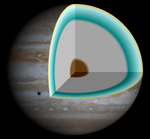Illustration of the interior of Jupiter, with a rocky core overlaid by a deep layer of metallic hydrogen
Every planet began its existence in an entirely fluid state; in early formation, the denser, heavier materials sank to the centre, leaving the lighter materials near the surface. Each therefore has a differentiated interior consisting of a dense planetary core surrounded by a mantle which either is or was a fluid. The terrestrial planets are sealed within hard crusts,
[116] but in the gas giants the mantle simply dissolves into the upper cloud layers. The terrestrial planets possess cores of magnetic elements such as iron and nickel, and mantles of silicates. Jupiter and Saturn are believed to possess cores of rock and metal surrounded by mantles of metallic hydrogen.
[117] Uranus and Neptune, which are smaller, possess rocky cores surrounded by mantles of water, ammonia, methane and other ices.
[118] The fluid action within these planets' cores creates a geodynamo that generates a magnetic field.
[116]
Atmosphere
See also: Extraterrestrial atmospheres
All of the Solar System planets have atmospheres as their large masses mean gravity is strong enough to keep gaseous particles close to the surface. The larger gas giants are massive enough to keep large amounts of the light gases hydrogen and helium close by, while the smaller planets lose these gases into space.
[119] The composition of the Earth's atmosphere is different from the other planets because the various life processes that have transpired on the planet have introduced free molecular oxygen.
[120] The only solar planet without a substantial atmosphere is Mercury which had it mostly, although not entirely, blasted away by the solar wind.
[121]
Planetary atmospheres are affected by the varying degrees of energy received from either the Sun or their interiors, leading to the formation of dynamic weather systems such as hurricanes, (on Earth), planet-wide dust storms (on Mars), an Earth-sized anticyclone on Jupiter (called the Great Red Spot), and holes in the atmosphere (on Neptune).
[104] At least one extrasolar planet, HD 189733 b, has been claimed to possess such a weather system, similar to the Great Red Spot but twice as large.
[122]
Hot Jupiters have been shown to be losing their atmospheres into space due to stellar radiation, much like the tails of comets These planets may have vast differences in temperature between their day and night sides which produce supersonic winds,
[125] although the day and night sides of HD 189733 b appear to have very similar temperatures, indicating that that planet's atmosphere effectively redistributes the star's energy around the planet.


0 comments:
Post a Comment